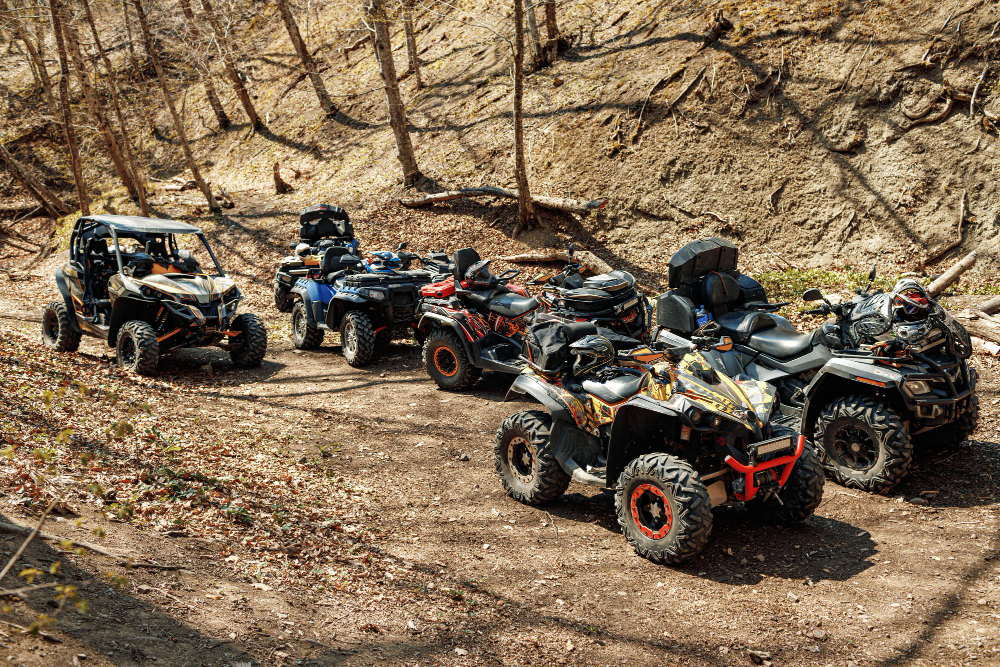ATV Safety Training: Navigating Alberta’s Terrain Safely
ATV safety training in Alberta is essential for navigating the province’s diverse terrain—ranging from foothills and wetlands to snowy northern trails. With rising off-road injuries and increasing ATV use in industries like forestry and agriculture, certified training ensures rider safety, regulatory compliance, and environmental responsibility. Courses teach emergency maneuvers, proper gear use, and terrain navigation. Whether for work or recreation, training minimizes risks and builds confidence. Learn more or enroll in certified programs at Southbrook Safety.
Why ATV Safety Training is Crucial in Alberta
Diverse Terrain and Harsh Weather Conditions
Alberta’s expansive geography offers everything from foothills and wetlands to dense forests and snow-covered plains. While this makes for exhilarating ATV rides, it also introduces unpredictable hazards. Rugged trails, steep inclines, loose rocks, and shifting weather patterns can challenge even the most experienced riders. ATV safety training in Alberta prepares operators to identify, assess, and respond to Alberta’s ever-changing landscape.
Off-Road Vehicle Injury Statistics in Alberta
Each year, Alberta sees numerous ATV-related injuries and fatalities, many of which are preventable. According to Alberta Health Services, ATV incidents are a leading cause of rural trauma admissions. Common causes include rollovers, collisions, and falls—often due to excessive speed, lack of protective gear, and poor judgment. Structured training helps mitigate these risks by instilling critical skills and safe riding practices.
Government Regulations and Licensing Requirements
In Alberta, ATVs are classified as off-highway vehicles and must comply with provincial regulations. Riders under 14 must be supervised, helmets are mandatory, and certain trails require a valid ATV safety course certification. Employers in forestry, oil & gas, and agriculture must also comply with Occupational Health and Safety (OHS) guidelines. Proper training from providers like Southbrook Safety ensures legal compliance and reduces employer liability.
Growing Use in Agriculture, Forestry & Oilfield Work
ATVs are now indispensable in rural and industrial Alberta. From checking fences in ranching zones to accessing remote job sites in the oil sands, these vehicles offer efficiency but demand caution. In work environments, one misstep can lead to serious consequences—not just for the operator but for the entire team. Certified ATV safety training, like the UTV course offered by Southbrook Safety, promotes a culture of responsibility and risk reduction.
Key Components of ATV Safety Courses in Alberta
Hands-On Terrain Navigation Practice
Effective ATV courses in Alberta combine classroom instruction with extensive hands-on training. Participants learn to maneuver through mud, sand, gravel, and steep grades in a controlled environment. This experiential learning ensures they’re prepared for real-world challenges.
Emergency Maneuvers and Obstacle Avoidance
Sudden wildlife crossings, unexpected drop-offs, or encountering other vehicles demand fast reflexes. Training includes drills in emergency braking, swerving, and controlled skids, teaching riders how to react under pressure.
Rules, Etiquette, and Responsible Trail Riding
ATV courses cover essential trail etiquette like yielding to others, respecting posted signs, and avoiding private property. This fosters a community of courteous and lawful riders.
Environmental Impact Awareness
Alberta’s diverse ecosystems are sensitive. Courses educate riders on avoiding erosion-prone areas, protecting wildlife habitats, and staying on designated trails to preserve the land for future generations.
Risk Assessment and Route Planning Skills
Knowing your route, checking weather forecasts, and preparing for emergencies are core skills taught in safety training. Riders learn how to plan safe rides and communicate their plans to others.
ATV Personal Protective Equipment (PPE) Essentials
Helmet Standards (DOT/CSA Approved)
The most vital piece of safety gear, helmets must meet CSA or DOT standards. Quality helmets reduce the risk of fatal head injuries and are required by law.
Eye and Face Protection Needs
Goggles or face shields protect against dust, debris, branches, and insects. For winter rides, dual-pane goggles help prevent fogging.
Gloves, Boots, and Body Armour Recommendations
Durable gloves enhance grip and reduce vibration. Sturdy, ankle-covering boots prevent crush injuries. Optional body armor and chest protectors add an extra layer of defense for challenging terrain.
Seasonal Gear for Alberta’s Winter Terrain
Cold weather ATVing requires insulated gloves, thermal layers, and windproof jackets. Frostbite and hypothermia are real risks in Alberta’s north, so proper gear is non-negotiable.
Common Safety Challenges in Alberta’s Off-Road Environments
Rocky Slopes and Muddy Trails in Foothills
Loose gravel and slick mud reduce traction. Training teaches throttle control and body positioning to maintain balance on unstable surfaces.
Water Crossings and Wetland Zones
Crossing creeks or marshes can be dangerous. Depth perception, current strength, and unseen obstacles are covered in safety protocols during certified training at Southbrook Safety.
Snowmobile-Specific Hazards in Northern Alberta
In winter, many ATVs are replaced by snowmobiles. Risks like thin ice, whiteout conditions, and mechanical failures are addressed in seasonal modules of safety courses.
Avoiding Wildlife and Environmental Disruption
Encounters with bears, moose, or cougars require calm, informed responses. Riders are also taught to avoid nesting areas and respect natural habitats.

Benefits of Completing a Certified ATV Course
Reduced Risk of Accidents and Rollovers
Studies show that trained riders are significantly less likely to suffer serious injuries. Safety courses emphasize proactive hazard avoidance and proper riding posture to prevent rollovers.
Improved Control and Handling Confidence
Knowledge breeds confidence. With proper training, even novice riders feel more in control, reducing panic and improving decision-making.
Lower Insurance Premiums and Legal Protection
Some insurance companies offer discounts for certified riders. In case of an incident, having proof of training can also help mitigate liability.
Employer Safety Compliance for Outdoor Jobs
Many Alberta employers in high-risk sectors now require ATV certification. Completing a course through Southbrook Safety boosts employability and ensures worksites meet provincial safety standards.
ATV Safety Tips for Solo and Group Riders
Pre-Ride Inspection Checklist
Check tire pressure, brakes, fuel levels, throttle response, and lights. Carry tools and know how to troubleshoot on the trail.
Safe Speeds for Various Terrain Types
Speed limits vary based on surface type. Training teaches when to slow down—especially around blind curves, steep hills, or during low visibility.
Group Communication and Route Protocols
Group riding calls for clear signals, staggered formation, and set meeting points. Radios or pre-agreed hand signals enhance coordination.
First Aid and Emergency Tools to Carry
Always carry a basic first aid kit, GPS or map, multi-tool, flashlight, and fire starter. Cell service may be limited, especially in the Rockies or northern bushlands.
Comparing ATV, UTV, ARGO, and Snowmobile Training Needs
Key Differences in Vehicle Controls and Hazards
While similar in function, ATVs, UTVs, ARGOs, and snowmobiles have unique control systems and stability profiles. Training differentiates each, ensuring safe operation regardless of the machine.
Who Should Take Which Course?
Recreational users typically start with ATV training. Workers in industrial settings may need specialized courses for UTVs or ARGOs. Snowmobile training is essential for winter operations.
Winter vs Summer Training Modules
Season-specific training prepares riders for unique challenges, like ice riding, blizzards, or rapid thaw conditions. Southbrook Safety offers seasonal modules in Alberta.
Combined Training Options Available in Alberta
Providers like Southbrook Safety offer bundled courses covering multiple vehicle types—ideal for employers and versatile riders.
Where to Get ATV Safety Training in Alberta
Approved Course Providers (Public & Private)
Southbrook Safety is among Alberta’s leading safety training providers. Look for instructors certified by the Canada Safety Council or Alberta OH&S-approved bodies.
What to Expect: Duration, Cost, and Requirements
Courses usually last one to two days and range from $150–$300. Participants must be at least 14 (with parental consent) and bring proper PPE.
Certifications Recognized by Employers and Insurance
Certificates from accredited training programs like those at Southbrook Safety are accepted by major Alberta employers and most insurance carriers. Be sure to verify recognition before enrolling.
Seasonal Scheduling & Booking Tips
Spring and summer fill up quickly. Book in advance, especially if seeking weekday slots. Winter training has limited availability and may require snow-specific vehicles.
Conclusion
Navigating Alberta’s stunning yet unpredictable terrain requires more than just horsepower—it demands preparation, awareness, and training. Whether you’re riding for fun or work, investing in ATV safety training is a smart, life-saving decision. Equip yourself with the skills, gear, and knowledge to enjoy Alberta’s outdoors responsibly. Explore certified ATV safety courses today at Southbrook Safety.
Frequently Asked Questions (FAQ)
Q1. Is ATV training mandatory in Alberta?
It’s not legally mandatory for recreational riders in all areas, but it is highly recommended. Employers often require certification for job site use.
Q2. What age can you ride an ATV in Alberta?
Riders under 14 must be supervised. Most safety courses require participants to be at least 14 years old.
Q3. How long does ATV safety training take?
Typically 6–8 hours of training, split between classroom and practical sessions. Some programs run over two days.
Q4. Will I get a certificate after completing the course?
Yes, most accredited programs provide a certificate recognized by employers and insurers.
Q5. What’s the cost of a certified ATV course in Alberta?
Prices range from $150–$300 depending on provider and vehicle type.

